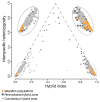Heterogeneous genome divergence, differential introgression, and the origin and structure of hybrid zones
- PMID: 26857437
- PMCID: PMC4899261
- DOI: 10.1111/mec.13582
Heterogeneous genome divergence, differential introgression, and the origin and structure of hybrid zones
Abstract
Hybrid zones have been promoted as windows on the evolutionary process and as laboratories for studying divergence and speciation. Patterns of divergence between hybridizing species can now be characterized on a genomewide scale, and recent genome scans have focused on the presence of 'islands' of divergence. Patterns of heterogeneous genomic divergence may reflect differential introgression following secondary contact and provide insights into which genome regions contribute to local adaptation, hybrid unfitness and positive assortative mating. However, heterogeneous genome divergence can also arise in the absence of any gene flow, as a result of variation in selection and recombination across the genome. We suggest that to understand hybrid zone origins and dynamics, it is essential to distinguish between genome regions that are divergent between pure parental populations and regions that show restricted introgression where these populations interact in hybrid zones. The latter, more so than the former, reveal the likely genetic architecture of reproductive isolation. Mosaic hybrid zones, because of their complex structure and multiple contacts, are particularly good subjects for distinguishing primary intergradation from secondary contact. Comparisons among independent hybrid zones or transects that involve the 'same' species pair can also help to distinguish between divergence with gene flow and secondary contact. However, data from replicate hybrid zones or replicate transects do not reveal consistent patterns; in a few cases, patterns of introgression are similar across independent transects, but for many taxa, there is distinct lack of concordance, presumably due to variation in environmental context and/or variation in the genetics of the interacting populations.
Keywords: FST outlier; cline; gene flow; genomic divergence; mosaic hybrid zone; speciation.
© 2016 John Wiley & Sons Ltd.
Figures


Similar articles
-
Differential introgression across newt hybrid zones: Evidence from replicated transects.Mol Ecol. 2019 Nov;28(21):4811-4824. doi: 10.1111/mec.15251. Epub 2019 Oct 20. Mol Ecol. 2019. PMID: 31549466
-
Reproductive isolation and introgression between sympatric Mimulus species.Mol Ecol. 2016 Jun;25(11):2499-517. doi: 10.1111/mec.13630. Epub 2016 May 11. Mol Ecol. 2016. PMID: 27038381
-
Tracking the progression of speciation: variable patterns of introgression across the genome provide insights on the species delimitation between progenitor-derivative spruces (Picea mariana × P. rubens).Mol Ecol. 2015 Oct;24(20):5229-47. doi: 10.1111/mec.13377. Epub 2015 Oct 12. Mol Ecol. 2015. PMID: 26346701
-
Hybridization and speciation.J Evol Biol. 2013 Feb;26(2):229-46. doi: 10.1111/j.1420-9101.2012.02599.x. J Evol Biol. 2013. PMID: 23323997 Review.
-
A Darwinian Laboratory of Multiple Contact Zones.Trends Ecol Evol. 2020 Nov;35(11):1021-1036. doi: 10.1016/j.tree.2020.07.015. Epub 2020 Sep 8. Trends Ecol Evol. 2020. PMID: 32912631 Review.
Cited by
-
Para-allopatry in hybridizing fire-bellied toads (Bombina bombina and B. variegata): Inference from transcriptome-wide coalescence analyses.Evolution. 2016 Aug;70(8):1803-18. doi: 10.1111/evo.12978. Epub 2016 Jul 8. Evolution. 2016. PMID: 27282112 Free PMC article.
-
Extensive Sympatry and Frequent Hybridization of Ecologically Divergent Aquatic Plants on the Qinghai-Tibetan Plateau.Front Plant Sci. 2022 May 12;13:851151. doi: 10.3389/fpls.2022.851151. eCollection 2022. Front Plant Sci. 2022. PMID: 35646042 Free PMC article.
-
Recent hybrids recapitulate ancient hybrid outcomes.Nat Commun. 2020 May 1;11(1):2179. doi: 10.1038/s41467-020-15641-x. Nat Commun. 2020. PMID: 32358487 Free PMC article.
-
The on-again, off-again relationship between mitochondrial genomes and species boundaries.Mol Ecol. 2017 Apr;26(8):2212-2236. doi: 10.1111/mec.13959. Epub 2017 Jan 27. Mol Ecol. 2017. PMID: 27997046 Free PMC article. Review.
-
Genomic, Phenotypic and Environmental Correlates of Speciation in the Midwife Toads (Alytes).Mol Ecol. 2025 Apr;34(8):e17736. doi: 10.1111/mec.17736. Epub 2025 Mar 25. Mol Ecol. 2025. PMID: 40130889 Free PMC article.
References
-
- Aboim MA, Mavarez J, Bernatchez L, Coelho MM. Introgressive hybridization between two Iberian endemic cyprinid fish: a comparison between two independent hybrid zones. Journal of Evolutionary Biology. 2010;23:817–828. - PubMed
-
- Allen JA. The Baeolophus bicolor-atricristatus group. Bulletin of the American Museum of Natural History. 1907;23:467–481.
-
- Barton NH, de Cara MAR. The evolution of strong reproductive isolation. Evolution. 2009;63:1171–1190. - PubMed
-
- Barton NH, Hewitt GM. Pp. in W R Atchley, and D S Woodruff, eds Evolution and speciation: essays in honour of M J D White. Cambridge Univ. Press; Cambridge, U.K: 1981. Hybrid zones and speciation; pp. 341–359.
Publication types
MeSH terms
Associated data
Grants and funding
LinkOut - more resources
Full Text Sources
Other Literature Sources
Miscellaneous

